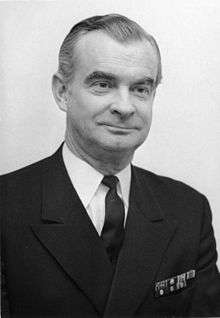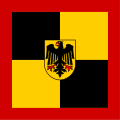Armin Zimmermann
Armin Zimmermann (23 December 1917 – 30 November 1976), was a German admiral and Inspector General of the Bundeswehr from 1 April 1972 until 30 November 1976. He joined the Kriegsmarine in 1937.
Armin Zimmermann | |
|---|---|
 Official portrait of Admiral Zimmermann | |
| Born | 23 December 1917 Blumenau, Brazil |
| Died | 30 November 1976 (aged 58) Bonn, Germany |
| Allegiance | |
| Service/ | Kriegsmarine GMSA German Navy |
| Years of service | 1937–1976 |
| Rank | Admiral |
| Commands held | Inspector General of the Bundeswehr |
Awards
- German Cross in Gold on 4 March 1942 as Oberleutnant zur See on R-45 in the 4. Räumboots-Flottille[1]
gollark: Go(lang) = bad.
gollark: ``` [...] MIPS is short for Millions of Instructions Per Second. It is a measure for the computation speed of a processor. Like most such measures, it is more often abused than used properly (it is very difficult to justly compare MIPS for different kinds of computers). BogoMips are Linus's own invention. The linux kernel version 0.99.11 (dated 11 July 1993) needed a timing loop (the time is too short and/or needs to be too exact for a non-busy-loop method of waiting), which must be calibrated to the processor speed of the machine. Hence, the kernel measures at boot time how fast a certain kind of busy loop runs on a computer. "Bogo" comes from "bogus", i.e, something which is a fake. Hence, the BogoMips value gives some indication of the processor speed, but it is way too unscientific to be called anything but BogoMips. The reasons (there are two) it is printed during boot-up is that a) it is slightly useful for debugging and for checking that the computer[’]s caches and turbo button work, and b) Linus loves to chuckle when he sees confused people on the news. [...]```I was wondering what BogoMIPS was, and wikipedia had this.
gollark: ```Architecture: x86_64CPU op-mode(s): 32-bit, 64-bitByte Order: Little EndianCPU(s): 8On-line CPU(s) list: 0-7Thread(s) per core: 2Core(s) per socket: 4Socket(s): 1NUMA node(s): 1Vendor ID: GenuineIntelCPU family: 6Model: 42Model name: Intel(R) Xeon(R) CPU E31240 @ 3.30GHzStepping: 7CPU MHz: 1610.407CPU max MHz: 3700.0000CPU min MHz: 1600.0000BogoMIPS: 6587.46Virtualization: VT-xL1d cache: 32KL1i cache: 32KL2 cache: 256KL3 cache: 8192KNUMA node0 CPU(s): 0-7Flags: fpu vme de pse tsc msr pae mce cx8 apic sep mtrr pge mca cmov pat pse36 clflush dts acpi mmx fxsr sse sse2 ss ht tm pbe syscall nx rdtscp lm constant_tsc arch_perfmon pebs bts rep_good nopl xtopology nonstop_tsc cpuid aperfmperf pni pclmulqdq dtes64 monitor ds_cpl vmx smx est tm2 ssse3 cx16 xtpr pdcm pcid sse4_1 sse4_2 x2apic popcnt tsc_deadline_timer aes xsave avx lahf_lm pti tpr_shadow vnmi flexpriority ept vpid xsaveopt dtherm ida arat pln pts```
gollark: I think it's a server thing.
gollark: My slightly newer SomethingOrOther 5000 does too.
References
Citations
- Patzwall & Scherzer 2001, p. 531.
Bibliography
- Patzwall, Klaus D.; Scherzer, Veit (2001). Das Deutsche Kreuz 1941 – 1945 Geschichte und Inhaber Band II [The German Cross 1941 – 1945 History and Recipients Volume 2] (in German). Norderstedt, Germany: Verlag Klaus D. Patzwall. ISBN 978-3-931533-45-8.CS1 maint: ref=harv (link)
External links
| Military offices | ||
|---|---|---|
| Preceded by General Ulrich de Maizière |
Chief of Staff of the Federal Armed Forces 1 April 1972–30 November 1976 |
Succeeded by General Harald Wust |
| Preceded by Vizeadmiral Karl Hetz |
Fleet Commander 1970–1972 |
Succeeded by Vizeadmiral Paul Hartwig |
This article is issued from Wikipedia. The text is licensed under Creative Commons - Attribution - Sharealike. Additional terms may apply for the media files.

